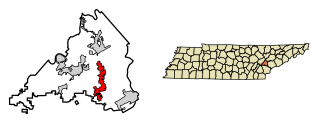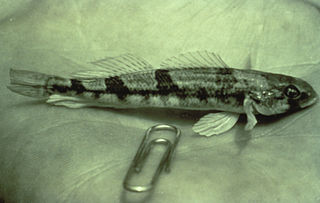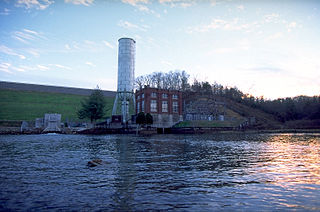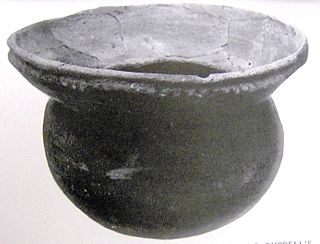
The Tennessee Valley Authority (TVA) is a federally owned electric utility corporation in the United States. TVA's service area covers all of Tennessee, portions of Alabama, Mississippi, and Kentucky, and small areas of Georgia, North Carolina, and Virginia. While owned by the federal government, TVA receives no taxpayer funding and operates similarly to a private for-profit company. It is headquartered in Knoxville, Tennessee, and is the sixth largest power supplier and largest public utility in the country.

The Little Tennessee River is a 135-mile (217 km) tributary of the Tennessee River that flows through the Blue Ridge Mountains from Georgia, into North Carolina, and then into Tennessee, in the southeastern United States. It drains portions of three national forests— Chattahoochee, Nantahala, and Cherokee— and provides the southwestern boundary of the Great Smoky Mountains National Park.

The snail darter is a small species of freshwater ray-finned fish, a darter from the subfamily Etheostomatinae, part of the family Percidae, which also contains the perches, ruffes and pikeperches. It is found in East Tennessee freshwater in the United States. First recorded in 1973, the snail darter was listed as endangered under the U.S. Endangered Species Act of 1973 by 1975. The species was at the center of a major environmental law controversy that involved a lawsuit seeking to halt the completion of Tellico Dam, which posed a risk of extinction for the snail darter by blocking its migratory route. The case was eventually appealed to the U.S. Supreme Court, which ruled on it in its 1978 decision Tennessee Valley Authority v. Hill.

Norris Dam is a hydroelectric and flood control structure located on the Clinch River in Anderson County and Campbell County, Tennessee, United States. The dam was the first major project for the Tennessee Valley Authority, which had been created in 1933 to bring economic development to the region and control the rampant flooding that had long plagued the Tennessee Valley. The dam was named in honor of Nebraska Senator George Norris (1861–1944), a longtime supporter of government-owned utilities in general, and supporter of TVA in particular. The infrastructure project was listed on the National Register of Historic Places in 2016.

John James Duncan Sr. was an American attorney and Republican politician who represented Tennessee's 2nd Congressional District in the U. S. House of Representatives from 1965 until his death in 1988. He also served as Mayor of Knoxville, Tennessee, from 1959 to 1964, and as assistant attorney general of Knox County, from 1948 until 1956. He is the father of Congressman John J. "Jimmy" Duncan, Jr., who succeeded him in Congress, and current Tennessee State Senator Becky Duncan Massey.

Tellico Dam is a dam built by the Tennessee Valley Authority (TVA) in Loudon County, Tennessee on the Little Tennessee River as part of the Tellico Project. Planning for a dam structure on the Little Tennessee was reported as early as 1936 but was dismissed until 1942 for official development. Unlike the agency's previous dams built for hydroelectric power and flood control, Tellico Dam would be constructed to support tourism and economic development through the planned city concept of Timberlake, which aimed to support a population of 30,000 in a region that was documented being in poor economic conditions. Completed in 1979, it created the Tellico Reservoir and is the last dam to be built by the Tennessee Valley Authority.

Tellico Village is an unincorporated planned community, and census-designated place on the western shore of Tellico Reservoir in Loudon County, Tennessee, United States, about 30 miles (48 km) southwest of Knoxville. Its population was 5,791 as of the 2010 census.

Fort Loudoun Dam is a hydroelectric dam on the Tennessee River in Loudon County, Tennessee, in the southeastern United States. The dam is operated by the Tennessee Valley Authority (TVA), which built the dam in the early 1940s as part of a unified plan to provide electricity and flood control in the Tennessee Valley and create a continuous 652-mile (1,049 km) navigable river channel from Knoxville, Tennessee to Paducah, Kentucky. It is the uppermost of nine TVA dams on the Tennessee River.

Fontana Dam is a hydroelectric dam on the Little Tennessee River in Swain and Graham counties, North Carolina, United States. The dam is operated by the Tennessee Valley Authority, which built the dam in the early 1940s to satisfy the skyrocketing electricity demands in the Tennessee Valley to support the aluminum industry at the height of World War II; it also provided electricity to a formerly rural area.

The snail darter controversy related to the discovery in 1973 of an endangered species during the construction of the Tellico Dam on the Little Tennessee River; the dam project had been authorized and begun before passage of protective environmental legislation. On August 12, 1973, University of Tennessee biologist and professor David Etnier discovered the snail darter in the Little Tennessee River while doing research related to a lawsuit under the National Environmental Policy Act (NEPA). The lawsuit said that the Tellico Reservoir, to be created by Tellico Dam, would alter the habitat of the river to the point of killing off the endangered snail darter.
Tellico Reservoir, also known as Tellico Lake, is a reservoir in Tennessee, created by the Tennessee Valley Authority (TVA) in 1979 upon the completion of Tellico Dam. The dam impounds the Little Tennessee River and the lower Tellico River. While TVA is careful to refer to its artificial lakes as reservoirs, common usage tends to refer to the reservoir as "Tellico Lake". The lake is approximately 16,000 acres in surface area and provides 357 miles of shoreline.

Hales Bar Dam was a hydroelectric dam once located on the Tennessee River in Marion County, Tennessee, United States. The Chattanooga and Tennessee River Power Company began building the dam on October 17, 1905, and completed it on November 11t, 1913, making Hales Bar one of the first major multipurpose dams and one of the first major dams to be built across a navigable channel in the United States. It began operation on November 13, 1913.

The Endangered Species Act (ESA) was first passed in 1973 and forms the basis of biodiversity and endangered species protection in the United States. The original purpose of the Endangered Species Act of 1973 was to prevent species endangerment and extinction due to the human impact on natural ecosystems. The three most powerful sections of the ESA are Sections 4,7 and 9. Section 4 allows the Secretaries of Interior and Commerce to list species as threatened or endangered based on best available data. Section 7 requires federal agencies to consult with Fish and Wildlife Service (FWS) or National Marine Fisheries Service (NMFS) before taking any action that may threaten a listed species. Section 9 forbids the taking of an endangered species. The first amendment to the ESA was passed by the 95th United States Congress in 1978 to "introduce some flexibility into the Endangered Species Act".

Sue Kerr Hicks was an American jurist who practiced law and served as a circuit court judge in the state of Tennessee. He is best known for his role as a co-instigator and prosecutor in the 1925 trial of John T. Scopes, a Dayton, Tennessee teacher accused of teaching the Theory of Evolution in violation of Tennessee state law. Hicks may have also been the inspiration for the Shel Silverstein song "A Boy Named Sue", which was popularized by Johnny Cash in 1969.

Blue Ridge Dam is a hydroelectric dam on the Toccoa River in Fannin County, in the U.S. state of Georgia. It is the uppermost of four dams on the Toccoa/Ocoee River owned and operated by the Tennessee Valley Authority. The dam impounds the 3,300-acre (1,300 ha) Blue Ridge Lake on the southwestern fringe of the Blue Ridge Mountains.

Bussell Island, formerly Lenoir Island, is an island located at the mouth of the Little Tennessee River, at its confluence with the Tennessee River in Loudon County, near the U.S. city of Lenoir City, Tennessee. The island was inhabited by various Native American cultures for thousands of years before the arrival of early European explorers. The Tellico Dam and a recreational area occupy part of the island. Part of the island was added in 1978 to the National Register of Historic Places for its archaeological potential.
Babbitt, Secretary of the Interior v. Sweet Home Chapter of Communities for a Great Oregon, 515 U.S. 687 (1995), is a US Supreme Court case, decided by a 6–3 vote, in which the plaintiffs challenged the Interior Department's interpretation of the word "harm" in the Endangered Species Act (ESA).

Rio Grande Silvery Minnow v. Bureau of Reclamation, called Rio Grande Silvery Minnow v. Keys in its earlier phases, was a case launched in 1999 by a group of environmentalists against the United States Bureau of Reclamation and the United States Army Corps of Engineers alleging violations of the Endangered Species Act and the National Environmental Policy Act. The case resulted in significant changes to water and river management in the Middle Rio Grande Basin of New Mexico in an effort to reverse the damage that had been done to the habitat of two endangered species.
This is a list of notable events relating to the environment in 1973. They relate to environmental law, conservation, environmentalism and environmental issues.

Poor Valley Creek State Park was a proposed state park in western Hawkins County, Tennessee, United States. It would have been located prominently near the Poor Valley Creek embayment of Cherokee Lake, an impoundment of the Holston River. The park was first planned in 1945, and shelved indefinitely following comments supporting "no action" on the project by state agencies in 1976.




















